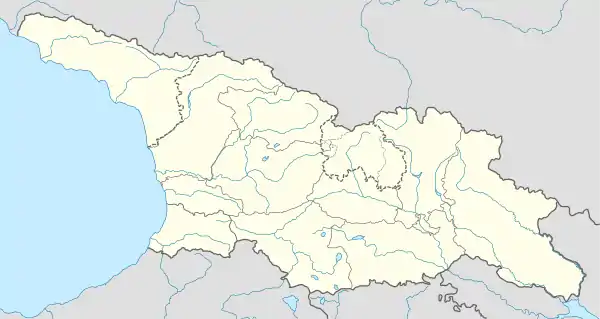Shaori fortress
The Shaori fortress (Georgian: შაორის ციხე, romanized: shaoris tsikhe) is a Bronze Age megalithic structure in the Akhalkalaki Municipality in Georgia's southern region of Samtskhe-Javakheti. A cyclopean fort built using a dry masonry technique, it has an unusual plan, rhomboid with circular spaces, and is situated on the eponymous rocky mount, at an altitude of 2752 meters above sea level, in the Lesser Caucasus mountains, northwest of Paravani Lake.[1][2] The fortress is inscribed on the list of the Immovable Cultural Monuments of National Significance of Georgia.[3]
| შაორის ციხე | |
.JPG.webp) Shaori fortress | |
 Location in Georgia | |
| Coordinates | 41.484858°N 43.746262°E |
|---|---|
| Location | Akhalkalaki Municipality, Samtskhe-Javakheti, Georgia |
| Type | Cyclopean fortress |
Architecture
.JPG.webp)
The Shaori fortress, formerly locally known also as Korogli (ultimately from Turkic Koroğlu), shares many topographical and architectural features with the Abuli fortress, another major cyclopean hillfort strategically located in the area around Paravani Lake.[1]
The Shaori fortress is built of large basalt blocks, without using mortar. It consists of two parts, each located on top of a steep peak. The central part is an irregular rectangle constructed in the highest area and can be accessed through a one-meter-wide and 1.3 meter-high gate from the east.[4] The location and spatial organization of Shaori makes it an unlikely domestic center.[2][4] Rather, it could have been used for religious purposes.[4]
Historical and archaeological background
The Shaori fortress first appears in literary sources in the geography of the early 18th-century Georgian scholar Prince Vakhushti.[1] Leon Melikset-Bek was the first who attempted to systematically study the monolithic monuments of Georgia, Shaori included, in 1938.[4]
No archaeological excavations have been carried out at Shaori, making it difficult to precisely date or assign the monument to any particular culture.[4][5] Similarity in construction technique and material with the Trialeti burial mounds has been observed, pointing to the first half of the 2nd millennium BC as a possible period of construction.[4]
In general, the spread of cyclopean fortresses is an archaeological testimony to the social changes in the South Caucasus in the Middle-to-Late Bronze Age, reflecting social differentiation and emergence of newly empowered elites. These forts were typically constructed on the steep slopes of mountains. Settlement distribution and cultural material suggest that those in charge of these hill forts exercised control over arable land and resources, but they may also have provided economic and defensive functions for their hinterlands.[6]
References
- Berdzenishvili, D. (2002). "ჯავახეთის ძველი სიმაგრეები [Old fortresses of Javakheti]". ჯავახეთი. ისტორია და თანამედროვეობა [Javakheti. History and the Present] (in Georgian). Akhaltsikhe. pp. 181–203.
- Sagona, Antonio (2017). The Archaeology of the Caucasus: From Earliest Settlements to the Iron Age. Cambridge University Press. pp. 378–379, 385–386. ISBN 9781139061254.
- "List of Immovable Cultural Monuments" (PDF) (in Georgian). National Agency for Cultural Heritage Preservation of Georgia. Retrieved 3 July 2019.
- Narimanishvili, Goderdzi; Khimshiashvili, Kakha (2009). "The Bronze Age Settlements from Trialeti". In Skinner, Peter; Tumanishvili, Dimiti; Shanshiashvili, Anna (eds.). Vakhtang Beridze 1st International Symposium of Georgian Culture — Georgian art in the context of European and Asian cultures; June 21-29, 2008, Georgia (PDF). Tbilisi. pp. 30–31. ISBN 978-9941-0-2005-6.
- Shanshashvili, Nino; Narimanishvili, Goderdzi (2014). "Environment and Dwelling in the Early and Middle Bronze Ages South Caucasus". In Narimanishvili, Goderdzi (ed.). International Conference: Problems of Early Metal age Archaeology of Caucasus and Anatolia. November 19-23, 2014 November 19-23, 2014, Georgia (PDF). Tbilisi. p. 247. ISBN 978-9941-0-7134-8.
- Sagona, Antonio (2017). The Archaeology of the Caucasus: From Earliest Settlements to the Iron Age. Cambridge University Press. pp. 378–379, 385–386. ISBN 9781139061254.